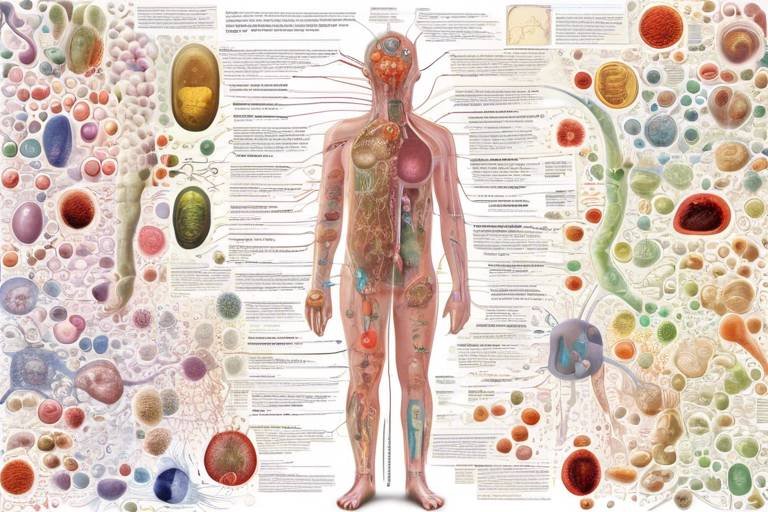The Biology of Fats - Good vs. Bad
Welcome to the fascinating world of dietary fats! It’s a topic that often gets a bad rap, but the truth is, fats are not all created equal. Understanding the difference between good and bad fats is essential for anyone looking to improve their health and nutrition. So, let’s dive into the complex biology of fats, exploring their roles in our bodies and how they can impact our overall well-being.
Fats are one of the three main macronutrients, alongside carbohydrates and proteins. They play a crucial role in our diet, serving as a primary energy source, supporting cell growth, and aiding in the absorption of vitamins A, D, E, and K. Without fats, our bodies would struggle to function optimally. However, not all fats are beneficial. Some can lead to serious health issues if consumed in excess. So, how do we navigate this slippery slope?
To make informed dietary choices, it’s vital to understand the different types of fats and their biological functions. Dietary fats can be categorized into three main types: saturated, unsaturated, and trans fats. Each has its own unique properties and health implications, which we will explore in detail. By the end of this article, you’ll have a clearer understanding of how to incorporate the right types of fats into your diet while avoiding those that can harm your health.
Dietary fats are essential for several reasons. They not only provide energy but also support vital bodily functions. For instance, fats are necessary for the construction of cell membranes, which protect our cells and allow them to function properly. Additionally, fats help to regulate hormones and play a role in signaling pathways throughout the body. Without adequate fat intake, we may face various health issues, including hormonal imbalances and nutrient deficiencies.
However, the type of fat you consume makes all the difference. While some fats can be incredibly beneficial, others can lead to negative health outcomes. This is why understanding the different types of fats is so important. Let’s break them down.
Fats can be broadly categorized into three types: saturated, unsaturated, and trans fats. Each type has distinct properties and health implications. Here’s a quick overview:
| Type of Fat | Properties | Health Implications |
|---|---|---|
| Saturated Fats | Solid at room temperature | Can raise cholesterol levels; should be consumed in moderation |
| Unsaturated Fats | Liquid at room temperature | Beneficial for heart health; includes monounsaturated and polyunsaturated fats |
| Trans Fats | Artificially created; solid at room temperature | Linked to increased heart disease risk; should be avoided |
By recognizing these categories, you can make better choices about the fats you include in your diet.
Saturated fats are typically found in animal products and are solid at room temperature. While they can be part of a healthy diet, it's essential to consume them in moderation. Foods high in saturated fats include:
- Meat (especially red meat)
- Dairy products (like cheese and butter)
- Certain oils (such as coconut and palm oil)
Excessive intake of saturated fats can lead to elevated cholesterol levels, which may increase your risk of heart disease. Therefore, moderation is key when incorporating these fats into your meals.
Research indicates that high consumption of saturated fats can raise LDL cholesterol levels, often referred to as "bad" cholesterol. This can contribute to the buildup of plaque in your arteries, increasing the risk of cardiovascular issues. It's not about eliminating saturated fats entirely, but rather about balancing them with healthier fat options.
On the flip side, unsaturated fats are generally considered beneficial for heart health. They are typically liquid at room temperature and can be found in foods like olive oil, avocados, nuts, and fatty fish. Unsaturated fats can be further divided into:
- Monounsaturated Fats: Found in olive oil, avocados, and nuts, these fats can help reduce bad cholesterol levels.
- Polyunsaturated Fats: Includes omega-3 and omega-6 fatty acids, which are essential for brain function and cell growth.
Incorporating these healthy fats into your diet can promote heart health and provide essential nutrients your body needs.
Trans fats, on the other hand, are the bad guys in the fat world. These are artificially created through a process called hydrogenation, which makes liquid oils solid. Trans fats are often found in processed foods, baked goods, and margarine. Understanding the dangers of trans fats is crucial for making healthier dietary choices.
Trans fats can raise LDL cholesterol while lowering HDL cholesterol, significantly increasing the risk of heart disease and stroke. Studies have shown that even small amounts of trans fats can have detrimental effects on health. Therefore, it’s essential to be aware of their presence in your diet.
Reading food labels is crucial for identifying trans fats. Many processed foods contain hidden trans fats, often listed under "partially hydrogenated oils." Being vigilant about label-reading can help you avoid these unhealthy fats and make better choices for your health.
Q: Are all fats bad for you?
A: No, not all fats are bad. Unsaturated fats are beneficial for heart health, while saturated fats should be consumed in moderation. Trans fats are the ones to avoid.
Q: How can I incorporate healthy fats into my diet?
A: You can include healthy fats by using olive oil for cooking, snacking on nuts, eating avocados, and choosing fatty fish like salmon.
Q: What are some foods high in trans fats?
A: Processed snacks, baked goods, and some margarines often contain trans fats. Always check the ingredient list for partially hydrogenated oils.

Understanding Dietary Fats
Dietary fats are often misunderstood, yet they play a crucial role in our overall health. Think of fats as the body's energy reserves; they provide the fuel we need to power through our daily activities. But that's not all! Fats also support cell growth and are essential for the absorption of fat-soluble vitamins like A, D, E, and K. Without adequate fat intake, our bodies would struggle to function optimally.
When we talk about dietary fats, it's important to recognize that not all fats are created equal. Some fats can be your best friends, while others can act like a sneaky villain in your diet. To make informed choices, we need to understand the different types of fats and their unique properties. For instance, unsaturated fats, which are typically found in plants and fish, can help reduce bad cholesterol levels, while saturated and trans fats can have the opposite effect.
Moreover, fats are not just a source of energy; they also play a role in maintaining body temperature and protecting our organs. Imagine fats as a cozy blanket, wrapping around your organs to keep them safe and warm. They also contribute to the flavor and texture of our food, making meals more enjoyable. However, the key is moderation. Too much of even the good fats can lead to weight gain and other health issues.
To simplify our understanding, let's break down dietary fats into three main categories:
- Saturated Fats: Typically solid at room temperature, found in animal products.
- Unsaturated Fats: Usually liquid at room temperature, including monounsaturated and polyunsaturated fats.
- Trans Fats: Artificially created fats that are harmful to health.
In conclusion, understanding dietary fats is not just about knowing what to eat but also about how to balance these fats in our diet. Keeping a keen eye on the types of fats we consume can lead to better health outcomes and a more enjoyable eating experience. So, the next time you're reaching for that snack, remember: it's not just about cutting out fats altogether; it's about choosing the right ones!

The Different Types of Fats
When we dive into the world of dietary fats, it’s essential to understand that not all fats are created equal. Just like people, fats have their unique personalities and roles in our diets. In general, dietary fats can be categorized into three main types: saturated fats, unsaturated fats, and trans fats. Each type comes with its own set of characteristics, health implications, and sources, which can significantly affect our overall well-being.
Saturated fats are usually solid at room temperature and are primarily found in animal products. Think of butter, cheese, and fatty cuts of meat. While they can contribute to a balanced diet, consuming them in excessive amounts may lead to health risks, particularly concerning heart health. Moderation is the key here; it’s like enjoying a rich dessert—too much can spoil the experience!
On the other hand, we have unsaturated fats, which are typically liquid at room temperature. These are the fats that our bodies crave and need for optimal functioning. Unsaturated fats are further divided into two categories: monounsaturated fats and polyunsaturated fats. Monounsaturated fats can be found in olive oil, avocados, and nuts, while polyunsaturated fats are abundant in fish, flaxseeds, and walnuts. These fats are beneficial for heart health, helping to lower bad cholesterol levels and reduce the risk of heart disease. They’re like the friendly neighbors who always bring a dish to share at potlucks—good for you and your community!
Finally, we encounter the notorious trans fats. These are the bad guys of the fat world, often found in processed foods and created through a process called hydrogenation. Trans fats can be harmful to your health, raising bad cholesterol (LDL) levels while lowering good cholesterol (HDL) levels. This double whammy significantly increases the risk of heart disease and stroke. It's crucial to be aware of trans fats and avoid them as much as possible. Think of trans fats as the party crashers who ruin a good time—better to keep them out of your diet!
To sum it up, understanding the different types of fats is vital for making informed dietary choices. Here’s a quick comparison to keep in mind:
| Type of Fat | State at Room Temperature | Sources | Health Implications |
|---|---|---|---|
| Saturated Fats | Solid | Meat, dairy products, coconut oil | Can raise cholesterol levels if consumed excessively |
| Unsaturated Fats | Liquid | Olive oil, avocados, nuts, fish | Beneficial for heart health, lowers bad cholesterol |
| Trans Fats | Solid | Processed foods, margarine | Raises bad cholesterol, lowers good cholesterol, increases heart disease risk |
By being aware of these different types of fats, you can make healthier choices that support your overall health and well-being. Remember, it’s not just about cutting out fats entirely; it’s about choosing the right types of fats that nourish your body and contribute positively to your health.

Saturated Fats
Saturated fats are an intriguing topic in the world of nutrition. Generally, these fats are solid at room temperature and are primarily found in animal-based products, such as red meat, butter, and cheese. But before you raise an eyebrow, let's dive deeper into what saturated fats actually do in our bodies. They play a crucial role in various biological functions, including supporting cell structure and hormone production. However, the conversation around saturated fats is not as straightforward as one might think.
While they can be a part of a balanced diet, moderation is essential. Think of saturated fats as that friend who can be fun at parties but might cause a little chaos if they overstay their welcome. Consuming them in excess can lead to health risks, particularly concerning heart health. The key here is to strike a balance. According to the American Heart Association, it’s recommended that saturated fat should make up no more than 5-6% of your total daily calorie intake. So, if you’re consuming 2,000 calories a day, that translates to about 120 calories or 13 grams of saturated fat.
To help you visualize this, here's a quick comparison of common sources of saturated fats:
| Food Item | Saturated Fat (grams per serving) |
|---|---|
| Butter (1 tablespoon) | 7 grams |
| Cheddar Cheese (1 ounce) | 6 grams |
| Beef (3 ounces, cooked) | 7 grams |
| Chicken Skin (1 piece) | 3 grams |
| Coconut Oil (1 tablespoon) | 12 grams |
As you can see, some foods pack a hefty punch of saturated fat. This is where being informed plays a significant role in your dietary choices. Recognizing these sources can help you manage your saturated fat intake effectively. But it’s not all doom and gloom; saturated fats can be part of a healthy diet when consumed in moderation. For example, when paired with a diet rich in fruits, vegetables, and whole grains, they can fit into an overall healthy lifestyle.
In conclusion, saturated fats are a mixed bag. They serve important functions in our bodies, but too much can lead to complications, particularly for heart health. So, the next time you're enjoying that juicy steak or creamy slice of cheesecake, remember: moderation is key. Consider balancing these indulgences with healthier fat options like avocados, nuts, and olive oil to keep your heart happy and healthy!
- What are saturated fats? Saturated fats are fats that are typically solid at room temperature and are found in animal products and some plant oils.
- Are all saturated fats bad? Not necessarily. While they should be consumed in moderation, some saturated fats can be part of a healthy diet.
- How much saturated fat should I consume? It's recommended that saturated fat makes up no more than 5-6% of your total daily calorie intake.
- What are some healthier alternatives to saturated fats? Healthier alternatives include unsaturated fats found in olive oil, avocados, nuts, and seeds.

Sources of Saturated Fats
Saturated fats are commonly found in a variety of foods, particularly those derived from animal sources. These fats play a significant role in our diets, but it's essential to be aware of their sources to manage intake effectively. While some saturated fats can be part of a balanced diet, excessive consumption may lead to health issues. So, where do we find these fats lurking?
One of the primary sources of saturated fats is meat. This includes red meats like beef, lamb, and pork, which are often rich in saturated fat. Processed meats such as sausages, bacon, and hot dogs also fall into this category, packing a hefty amount of saturated fat into each serving. Additionally, dairy products are another significant contributor. Whole milk, cheese, and butter are delicious staples in many diets, but they also contain high levels of saturated fats.
Moreover, certain oils can be surprising sources of saturated fats. For instance, palm oil and coconut oil, often touted for their health benefits, are predominantly saturated fats. While they can be used in moderation, it's crucial to be mindful of their presence in many processed foods. Here's a brief overview of common sources:
- Meat: Beef, pork, lamb, and processed meats
- Dairy: Whole milk, cream, cheese, and butter
- Oils: Palm oil, coconut oil, and some margarines
It's important to remember that not all saturated fats are created equal. Some sources, like dairy, can also provide essential nutrients such as calcium and vitamin D. Thus, moderation and balance are key. Incorporating a variety of food sources while being aware of saturated fat content can help maintain a healthy diet without sacrificing flavor.

Health Implications of Saturated Fats
When it comes to saturated fats, the conversation can get a bit murky. These fats, often found in animal products, can be both friends and foes in our diets. On one hand, they play a role in providing energy and supporting cell structure. But on the other hand, excessive consumption can lead to serious health concerns. It's like having a double-edged sword—useful in moderation, but potentially harmful if overindulged.
Research has shown a strong link between high saturated fat intake and elevated cholesterol levels. This is particularly concerning because high cholesterol is a well-known risk factor for heart disease. Imagine your arteries as highways; too much cholesterol can create traffic jams, leading to blockages that can ultimately cause heart attacks or strokes. The American Heart Association suggests limiting saturated fat to less than 10% of your total daily calories. For most adults, that translates to about 22 grams of saturated fat per day.
To put it into perspective, here’s a quick breakdown of how common foods stack up in terms of saturated fat content:
| Food Item | Saturated Fat (grams per serving) |
|---|---|
| Butter (1 tablespoon) | 7 |
| Cheddar Cheese (1 ounce) | 6 |
| Beef (3 ounces, cooked) | 8 |
| Coconut Oil (1 tablespoon) | 12 |
This table illustrates how easily saturated fat can sneak into your diet. While it’s not necessary to eliminate saturated fats entirely, being aware of their sources and keeping an eye on your intake can make a significant difference in your overall health. Think of it as balancing your checkbook; you want to ensure that your “spending” on saturated fats doesn’t surpass your “income” of healthy fats and nutrients.
In summary, while saturated fats can be part of a balanced diet, moderation is crucial. It’s all about finding that sweet spot where you can enjoy your favorite foods without compromising your heart health. So, the next time you’re considering that slice of pizza or a creamy dessert, ask yourself: Is it worth the cholesterol? Your heart will thank you for the careful consideration!
- What are saturated fats? Saturated fats are a type of fat found in various foods, primarily from animal sources, and are typically solid at room temperature.
- Are all saturated fats bad for you? Not necessarily. While excessive intake can lead to health issues, some saturated fats can be part of a healthy diet when consumed in moderation.
- How can I reduce saturated fat in my diet? You can reduce saturated fat by choosing lean meats, low-fat dairy products, and incorporating more plant-based oils and foods into your meals.

Unsaturated Fats
Unsaturated fats are often celebrated as the good fats in our diets, and for good reason! Unlike their saturated counterparts, these fats are typically liquid at room temperature. They come primarily from plant sources and fish, making them an essential part of a balanced diet. But what exactly makes them so beneficial?
There are two main types of unsaturated fats: monounsaturated fats and polyunsaturated fats. Each type has its unique properties and health benefits. Monounsaturated fats, found in foods like olive oil, avocados, and nuts, have been shown to help reduce bad cholesterol levels, which can lower the risk of heart disease. On the other hand, polyunsaturated fats, which include omega-3 and omega-6 fatty acids found in fatty fish, flaxseeds, and walnuts, are crucial for brain function and cell growth.
Incorporating unsaturated fats into your diet can be as simple as swapping out butter for olive oil when cooking or adding a handful of nuts to your salad. They not only enhance the flavor of your meals but also provide essential nutrients that your body craves. However, moderation is key! Even though these fats are healthier, they are still calorie-dense. Therefore, it's important to enjoy them in appropriate amounts.
Here’s a quick comparison of the two types of unsaturated fats:
| Type of Unsaturated Fat | Sources | Health Benefits |
|---|---|---|
| Monounsaturated Fats | Olive oil, avocados, nuts | Lower bad cholesterol, reduce heart disease risk |
| Polyunsaturated Fats | Fatty fish, flaxseeds, walnuts | Essential for brain function, cell growth |
In conclusion, unsaturated fats play a crucial role in our health. They not only help maintain a healthy heart but also support various bodily functions. So, next time you're planning your meals, think about incorporating more of these nutrient-rich fats into your diet!
- What are unsaturated fats? Unsaturated fats are fats that remain liquid at room temperature and are considered beneficial for heart health.
- What foods are high in unsaturated fats? Foods such as olive oil, avocados, nuts, and fatty fish are rich in unsaturated fats.
- How do unsaturated fats benefit my health? They help lower bad cholesterol levels, reduce the risk of heart disease, and support brain function.
- Can I consume unsaturated fats freely? While they are healthier, moderation is still important as they are calorie-dense.

Trans Fats: The Bad Fats
When we talk about dietary fats, not all fats are created equal. In fact, there’s a category that stands out as particularly harmful: trans fats. These fats are often found in processed foods and are notorious for their negative health impacts. But what exactly are trans fats, and why should we be wary of them? Let’s dive into the nitty-gritty of these bad fats and uncover the dangers they pose to our health.
Trans fats are artificially created through a process called hydrogenation, which turns liquid vegetable oils into solid fats. This process not only extends the shelf life of products but also improves texture and flavor. However, the benefits for manufacturers come at a steep cost to our health. Trans fats have been linked to a slew of health issues, making them a dietary villain in the eyes of nutritionists and health experts alike.
One of the most alarming effects of trans fats is their impact on cholesterol levels. They can raise LDL cholesterol (the "bad" cholesterol) while simultaneously lowering HDL cholesterol (the "good" cholesterol). This double whammy significantly increases the risk of heart disease and stroke. In fact, studies have shown that consuming just 2 grams of trans fats per day can increase the risk of heart disease by as much as 23%!
So, how can you protect yourself from these harmful fats? The first step is to be vigilant about reading food labels. Many processed foods, such as baked goods, snacks, and margarine, can contain hidden trans fats. Here’s a quick guide to help you identify trans fats in your food:
- Look for the term “partially hydrogenated oils” in the ingredient list.
- Check the nutrition facts for trans fat content. If it lists any amount, it’s best to avoid that product.
- Be cautious with foods labeled as "trans fat-free," as they can still contain up to 0.5 grams of trans fats per serving.
Awareness is key when it comes to trans fats. Many countries have implemented regulations to limit or ban trans fats in food products, but they can still be found in some places. Being proactive about your dietary choices can help you steer clear of these bad fats. Opting for whole, unprocessed foods is a great way to minimize your intake of trans fats.
In summary, trans fats are a prime example of how not all fats are beneficial. While some fats can support your health, trans fats are firmly on the "do not eat" list. By understanding their dangers and learning how to identify them, you can make healthier choices for your diet and overall well-being. Remember, your heart will thank you!
What are trans fats?
Trans fats are artificially created fats formed during the hydrogenation process, which solidifies liquid vegetable oils. They are often found in processed foods.
Why are trans fats harmful?
Trans fats raise LDL cholesterol and lower HDL cholesterol, significantly increasing the risk of heart disease and stroke.
How can I avoid trans fats?
To avoid trans fats, read food labels carefully, look for “partially hydrogenated oils” in the ingredient list, and choose whole, unprocessed foods.
Are there any regulations on trans fats?
Yes, many countries have implemented regulations to limit or ban trans fats in food products, but it's still important to be vigilant as they can be present in some foods.

Health Risks Associated with Trans Fats
When it comes to dietary choices, trans fats are the villains of the story. These fats are not just bad; they're downright dangerous! Created through a process called hydrogenation, trans fats are often found in processed foods, and they can wreak havoc on your health. But what exactly makes them so harmful? Let's dig deeper.
One of the most alarming effects of trans fats is their ability to disrupt your cholesterol levels. They tend to raise LDL cholesterol (the "bad" cholesterol) while lowering HDL cholesterol (the "good" cholesterol). This double whammy significantly increases your risk of heart disease. In fact, studies have shown that consuming just a few grams of trans fats can raise your risk of heart disease by as much as 23%. Isn’t that shocking?
But that’s not all! Trans fats have also been linked to other serious health issues, including:
- Stroke: The imbalance of cholesterol caused by trans fats can lead to the formation of plaques in your arteries, which increases your risk of stroke.
- Type 2 Diabetes: Some research suggests a connection between trans fat consumption and insulin resistance, a precursor to diabetes.
- Inflammation: Trans fats may promote inflammation in the body, contributing to various chronic diseases.
Now, you might be wondering, "How can I avoid these nasty fats?" The first step is to become a savvy label reader. Many processed foods, such as baked goods, snacks, and fried foods, contain hidden trans fats. Even if a product claims to have "0 grams of trans fat," it may still contain up to 0.5 grams per serving. It’s crucial to check the ingredient list for terms like "partially hydrogenated oils," which indicate the presence of trans fats.
In summary, the health risks associated with trans fats are severe and far-reaching. By steering clear of these harmful fats and making informed dietary choices, you can significantly reduce your risk of heart disease and other health complications. Remember, your health is your wealth, and avoiding trans fats is a step in the right direction!
1. What are trans fats?
Trans fats are artificially created fats that are formed through the hydrogenation process, which makes liquid oils solid at room temperature.
2. Why are trans fats considered unhealthy?
Trans fats raise LDL cholesterol and lower HDL cholesterol, increasing the risk of heart disease, stroke, and other chronic health conditions.
3. How can I identify trans fats in food?
Always read food labels and ingredient lists. Look for "partially hydrogenated oils," which indicate the presence of trans fats, even if the label states "0 grams of trans fat."
4. Are there any safe levels of trans fat consumption?
No, health experts recommend eliminating trans fats from your diet as much as possible to reduce health risks.

Identifying Trans Fats in Food
Identifying trans fats in food can feel like searching for a needle in a haystack, especially with the myriad of processed foods available today. These harmful fats are often hidden in items you wouldn’t expect, making it crucial to be a vigilant consumer. Trans fats are typically found in partially hydrogenated oils, which are used to enhance flavor and extend shelf life. However, they come with a hefty price tag on your health. So, how do you spot these sneaky fats? It all starts with reading food labels.
When you're perusing the grocery aisle, the first thing to do is check the Nutrition Facts label. Look for the section that lists total fat, saturated fat, and trans fat. If you see “0 grams” of trans fat, you might think you’re in the clear. But wait! The FDA allows products to claim “0 grams” if they contain less than 0.5 grams per serving. This means you could be consuming trans fats without even realizing it, especially if you have multiple servings. Therefore, it’s essential to look at the ingredient list as well.
Ingredients are where the real culprits lie. If you see the term “partially hydrogenated oil”, it’s a clear sign that trans fats are present, regardless of what the nutrition label states. These oils are often found in a variety of processed foods, including:
- Fried foods (like doughnuts and French fries)
- Baked goods (such as cookies, cakes, and pastries)
- Snacks (including microwave popcorn and crackers)
- Non-dairy coffee creamers
- Frozen pizzas and other convenience foods
Another important tip is to be wary of products marketed as “trans fat-free” or “zero trans fats.” Companies often use clever marketing tactics to make their products seem healthier than they actually are. Always double-check the ingredients and nutritional content. If you’re unsure about a product, it’s often best to choose whole, unprocessed foods like fruits, vegetables, whole grains, and lean proteins. These foods naturally contain little to no trans fats and are much better for your overall health.
In summary, identifying trans fats requires a bit of detective work. By reading labels carefully and understanding the ingredients, you can protect yourself from the hidden dangers of trans fats. Remember, your health is worth the effort!
1. What are trans fats?
Trans fats are a type of unsaturated fat that has been partially hydrogenated, making them solid at room temperature. They are often found in processed foods and are linked to various health risks.
2. Why are trans fats harmful?
Trans fats can raise bad cholesterol (LDL) levels while lowering good cholesterol (HDL) levels, increasing the risk of heart disease, stroke, and type 2 diabetes.
3. How can I avoid trans fats?
To avoid trans fats, read nutrition labels carefully, look for “partially hydrogenated oils” in the ingredient list, and choose whole, unprocessed foods whenever possible.
4. Are there any safe levels of trans fats?
There is no safe level of trans fats; even small amounts can be harmful to your health. It's best to avoid them entirely.
5. Can I trust “trans fat-free” labels?
Not always. Products can claim to be “trans fat-free” if they contain less than 0.5 grams per serving. Always check the ingredient list for partially hydrogenated oils.
Frequently Asked Questions
- What are dietary fats and why are they important?
Dietary fats are essential macronutrients that provide energy, support cell growth, and help absorb vitamins. They play a crucial role in maintaining overall health and are necessary for various bodily functions.
- What is the difference between saturated and unsaturated fats?
Saturated fats are typically solid at room temperature and are found in animal products, while unsaturated fats are usually liquid and come from plant sources. Unsaturated fats are generally considered healthier for heart health compared to saturated fats.
- Are all saturated fats bad for you?
Not necessarily! While excessive intake of saturated fats can lead to health risks, moderate consumption can be part of a balanced diet. It's all about finding the right balance and being mindful of your overall fat intake.
- What are trans fats and why should I avoid them?
Trans fats are artificially created through hydrogenation and have been linked to numerous health issues, including heart disease. They can raise bad cholesterol (LDL) and lower good cholesterol (HDL), making them particularly harmful.
- How can I identify trans fats in food?
Reading food labels is essential for identifying trans fats. Look for "partially hydrogenated oils" in the ingredient list, as this indicates the presence of trans fats. It's important to be vigilant, as many processed foods may contain hidden trans fats.
- What are some healthy sources of fats?
Healthy sources of fats include avocados, nuts, seeds, olive oil, and fatty fish like salmon. These foods provide beneficial unsaturated fats that can support heart health and overall well-being.
- How much fat should I include in my diet?
The recommended dietary fat intake varies, but a general guideline is that fats should make up about 20-35% of your total daily calories. Focus on incorporating healthy fats while limiting saturated and trans fats.
- Can I lose weight while eating fats?
Absolutely! Fats can be part of a weight loss plan. The key is to choose healthy fats and consume them in moderation. They can help you feel full and satisfied, making it easier to stick to your dietary goals.



















